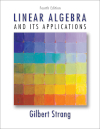- About MAA
- Membership
- MAA Publications
- Periodicals
- Blogs
- MAA Book Series
- MAA Press (an imprint of the AMS)
- MAA Notes
- MAA Reviews
- Mathematical Communication
- Information for Libraries
- Author Resources
- Advertise with MAA
- Meetings
- Competitions
- Programs
- Communities
- MAA Sections
- SIGMAA
- MAA Connect
- Students
- MAA Awards
- Awards Booklets
- Writing Awards
- Teaching Awards
- Service Awards
- Research Awards
- Lecture Awards
- Putnam Competition Individual and Team Winners
- D. E. Shaw Group AMC 8 Awards & Certificates
- Maryam Mirzakhani AMC 10 A Awards & Certificates
- Two Sigma AMC 10 B Awards & Certificates
- Jane Street AMC 12 A Awards & Certificates
- Akamai AMC 12 B Awards & Certificates
- High School Teachers
- News
You are here
Linear Algebra and Its Applications

Publisher:
Cengage Learning
Publication Date:
2006
Number of Pages:
544
Format:
Hardcover
Edition:
4
Price:
140.95
ISBN:
0030105676
Category:
Textbook
[Reviewed by , on ]
Allen Stenger
12/28/2021
This is a good introductory text in linear algebra, although it has been largely superseded by a later book by the same author (more on that at the end of this review). This is a matrix-oriented book, although the first problem it tackles is the solution of systems of linear equations. Vectors and matrices are introduced almost immediately as a way to organize and think about systems of linear equations. After a thorough study of these systems in Chapter 1, it switches viewpoints in Chapter 2 to deal with vectors, vectors spaces, and matrices as operators on vector spaces. There is a strong emphasis on the “Four Fundamental Subspaces” of a matrix (column space, null space, row space, and left null space). Chapter 3 continues this with the study of orthogonality. Chapter 4 switches viewpoints to determinants.
Chapter 5 is where the book really begins to study matrices in themselves, with a detailed study of eigenvalues, eigenvectors, and their properties. This includes a number of applications. Chapter 6 deals specifically with positive definite matrices, and includes some material on singular value decomposition.
There are two kinds of treatments of applications. The first kind, which is scattered throughout the book wherever it is relevant, consists of brief sketches of how linear algebra can be used. I think these are intended more for motivation than to teach the specifics of how to apply linear algebra. The second kind of treatment is much more thorough and comprises the last two chapters. Chapter 7 deals with numerical methods and algorithms, and Chapter 8 is a detailed study of linear programming and some applications to networks and to game theory.
Brief answers to the odd-numbered problems are in the back of the book. The publisher offers a Student Solutions Manual; I have not seen this and do not know what additional information it contains.
Now to look at the immediate competition. This book was first published in 1976 and last updated in 2005. In the meantime, Strang has written another book (self published), Introduction to Linear Algebra, last updated in 2016. This is the current text for MIT’s course 18.06, and has the same organization and approach to the subject as the present book. The author’s approach has evolved somewhat over the years, and in particular, there is a much more detailed study of singular value decomposition.
The newer book has a more modern layout with lots of highlighting and sidebars, and the narrative and problem sections are broken into smaller pieces. Despite not having “Applications” in the title, it does have a variety of applications, although for the most part they are gathered in the last chapter and not scattered through the book. These treatments are brief but are detailed enough that the student will learn how to make this kind of application.
Allen Stenger is a math hobbyist and retired software developer. He was Number Theory Editor of the Missouri Journal of Mathematical Sciences from 2010 through 2021. His personal website is allenstenger.com. His mathematical interests are number theory and classical analysis.
1. MATRICES AND GAUSSIAN ELIMINATION.
Introduction. The Geometry of Linear Equations. An Example of Gaussian Elimination. Matrix Notation and Matrix Multiplication. Triangular Factors and Row Exchanges. Inverses and Transposes. Special Matrices and Applications. Review Exercises.
2. VECTOR SPACES.
Vector Spaces and Subspaces. The Solution of m Equations in n Unknowns. Linear Independence, Basis, and Dimension. The Four Fundamental Subspaces. Networks and Incidence Matrices. Linear Transformations. Review Exercises.
3. ORTHOGONALITY.
Perpendicular Vectors and Orthogonal Subspaces. Inner Products and Projections onto Lines. Least Squares Approximations. Orthogonal Bases, Orthogonal Matrices, and Gram-Schmidt Orthogonalization. The Fast Fourier Transform. Review and Preview. Review Exercises.
4. DETERMINANTS.
Introduction. Properties of the Determinant. Formulas for the Determinant. Applications of Determinants. Review Exercises.
5. EIGENVALUES AND EIGENVECTORS.
Introduction. Diagonalization of a Matrix. Difference Equations and the Powers Ak. Differential Equations and the Exponential eAt. Complex Matrices: Symmetric vs. Hermitian. Similarity Transformations. Review Exercises.
6. POSITIVE DEFINITE MATRICES.
Minima, Maxima, and Saddle Points. Tests for Positive Definiteness. The Singular Value Decomposition. Minimum Principles. The Finite Element Method.
7. COMPUTATIONS WITH MATRICES.
Introduction. The Norm and Condition Number. The Computation of Eigenvalues. Iterative Methods for Ax = b.
8. LINEAR PROGRAMMING AND GAME THEORY.
Linear Inequalities. The Simplex Method. Primal and Dual Programs. Network Models. Game Theory.
Appendix A: Computer Graphics.
Appendix B: The Jordan Form.
References.
Solutions to Selected Exercises.
Index.
- Log in to post comments




